Probabilistic Projections of South Korea’s Population Decline and Subnational Dynamics
Abstract
1. Introduction
2. Korea and Subnational Context
3. Data
4. Methods
4.1. Probabilistic Cohort-Component Method
4.2. Subnational TFR Projection
4.3. Subnational e0 Projection
4.4. Subnational NMR Projection
4.5. Subnational Probabilistic Population Projection
5. Result
5.1. National Projection
5.2. Subnational Projection
6. Validation Test
7. Discussion
8. Conclusions
Funding
Data Availability Statement
Conflicts of Interest
References
- Cannan, E. The Probability of Cessation of the Growth of Population in England and Wales during the next Century. Econ. J. 1895, 5, 506–515. [Google Scholar] [CrossRef]
- Bowley, A. Births and Population in Great Britain. Econ. J. 1924, 34, 188–192. [Google Scholar] [CrossRef]
- Whelpton, P. The Population of the United States, 1925 to 1975. Am. J. Sociol. 1928, 34, 253–270. [Google Scholar] [CrossRef]
- Smith, S.; Tayman, J.; Swanson, D.A. State and Local Population Projections: Methodology and Analysis; Kluwer Academic Press: New York, NY, USA, 2001. [Google Scholar]
- Bongaarts, J.; Bulatao, R.A. (Eds.) Beyond Six Billion: Forecasting the World’s Population; National Academy Press: Washington, DC, USA, 2000. [Google Scholar]
- Lutz, W.; KC, S. Dimensions of global population projections: What do we know about future population trends and structures? Philos. Trans. R. Soc. B 2010, 365, 2779–2791. [Google Scholar] [CrossRef] [PubMed]
- United Nations Department of Economic and Social Affairs. World Population Prospects 2024 Dataset. 2024. Available online: https://www.un.org/development/desa/pd/content/world-population-prospects-2024-dataset (accessed on 25 June 2025).
- Raftery, A.E.; Chunn, J.L.; Gerland, P.; Ševčíková, H. Bayesian probabilistic projections of life expectancy for all countries. Demography 2013, 50, 777–801. [Google Scholar] [CrossRef] [PubMed]
- Raftery, A.E.; Alkema, L.; Gerland, P. Bayesian population projections for the United Nations. Stat. Sci. 2014, 29, 58–68. [Google Scholar] [CrossRef] [PubMed]
- Raftery, A.E.; Lalic, N.; Gerland, P. Joint probabilistic projection o f female and male life expectancy. Demogr. Res. 2014, 30, 795–822. [Google Scholar] [CrossRef] [PubMed]
- Alexander, M.; Zagheni, E.; Barbieri, M. A flexible Bayesian model for estimating subnational mortality. Demography 2017, 54, 2025–2041. [Google Scholar] [CrossRef] [PubMed]
- Congdon, P. Life expectancies for small areas: A Bayesian random effects methodology. Int. Stat. Rev. 2009, 77, 222–240. [Google Scholar] [CrossRef]
- Jonker, M.F.; van Lenthe, F.J.; Congdon, P.D.; Donkers, B.; Burdorf, A.; Mackenbach, J.P. Comparison of Bayesian random-effects and traditional life expectancy estimations in small-area applications. Am. J. Epidemiol. 2012, 176, 929–937. [Google Scholar] [CrossRef] [PubMed]
- Wakefield, J.; Fuglstad, G.-A.; Riebler, A.; Godwin, J.; Wilson, K.; Clark, S.J. Estimatingunder-five mortality in space and time in a developing world context. Stat. Methods Med. Res. 2019, 28, 2614–2634. [Google Scholar] [CrossRef] [PubMed]
- Bryant, J.; Zhang, J.L. Bayesian forecasting of demographic rates for small areas: Emigration rates by age, sex, and region in New Zealand, 2014–2038. Stat. Sin. 2016, 26, 1337–1363. [Google Scholar] [CrossRef][Green Version]
- Zhang, J.L.; Bryant, J. Bayesian disaggregated forecasts: Internal migration in Iceland. In Developments in Demographic Forecasting; Mazzuco, S., Keilman, N., Eds.; Springer: Cham, Switzerland, 2020; pp. 193–215. [Google Scholar] [CrossRef]
- Lee, R.D.; Carter, L.R. Modeling and forecasting U.S. mortality. J. Am. Stat. Assoc. 1992, 87, 659–671. [Google Scholar] [CrossRef]
- Cameron, M.P.; Poot, J. Lessons from stochastic small-area population projections: The case of Waikato subregions in New Zealand. J. Popul. Res. 2011, 28, 245–265. [Google Scholar] [CrossRef]
- Wilson, T.; Brokensha, H.; Rowe, F.; Simpson, L. Insights from the evaluation of past localarea population forecasts. Popul. Res. Policy Rev. 2018, 37, 137–155. [Google Scholar] [CrossRef]
- Ševčíková, H.; Raftery, A.E. Probabilistic projection of subnational life expectancy. J. Off. Stat. 2021, 37, 591–610. [Google Scholar] [CrossRef] [PubMed]
- Azose, J.; Sevcikova, H.; Raftery, A. bayesMig: Bayesian Projection of Migration (R Package Version 0.2-3). 2022. Available online: https://github.com/PPgp/bayesMig (accessed on 13 December 2023).
- Sevcikova, H.; Raftery, A.E.; Gerland, P. Probabilistic projection of subnational total fertility rates. Demogr. Res. 2018, 38, 1843–1884. [Google Scholar] [CrossRef] [PubMed]
- Rayer, S. Demographic techniques: Small-area estimates and projections. In International Handbook of Population Studies; Springer: Berlin/Heidelberg, Germany, 2015; pp. 345–367. Available online: https://bebr.ufl.edu/sites/default/files/Research%20Reports/Rayer%20%282015%29%20-%20ISB2.pdf (accessed on 25 June 2025).
- Smith, J.; Johnson, L. Methods for small area population forecasts: State-of-the-art and research needs. J. Popul. Res. 2021, 38, 123–145. [Google Scholar] [CrossRef]
- Yu, C.C.; Ševčíková, H.; Raftery, A.E.; Curran, S.R. Probabilistic county-level population projections. Demography 2023, 60, 915–937. [Google Scholar] [CrossRef] [PubMed]
- Swanson, D.A.; Beck, D.M. A new short-term county population projection method. J. Econ. Soc. Meas. 1994, 20, 25–50. [Google Scholar] [CrossRef]
- Wilson, T.; Grossman, I.; Alexander, M.; Rees, P.; Temple, J. Methods for small area population forecasts: State-of-the-art and research needs. Popul. Res. Policy Rev. 2022, 41, 865–898. [Google Scholar] [CrossRef] [PubMed]
- Raftery, A.E.; Li, N.; Ševčíková, H.; Gerland, P.; Heilig, G.K. Bayesian probabilistic population projections for all countries. Proc. Natl. Acad. Sci. USA 2012, 109, 13915–13921. [Google Scholar] [CrossRef] [PubMed]
- Alkema, L.; Raftery, A.E.; Gerland, P.; Clark, S.J.; Pelletier, F.; Buettner, T.; Heilig, G.K. Probabilistic projections of the total fertility rate for all countries. Demography 2011, 48, 815–839. [Google Scholar] [CrossRef] [PubMed]
- Lee, R.; Miller, T.; Edwards, R.D. The Growth and Aging of California’s Population: Demographic and fiscal Projections, Characteristics and Service Needs. 2003. Available online: http://repositories.cdlib.org/cgi/viewcontent.cgi?article=1006&context=iber/ceda (accessed on 25 June 2025).
- Rayer, S.; Smith, S.K.; Tayman, J. Empirical prediction intervals for county population forecasts. Popul. Res. Policy Rev. 2009, 28, 773–793. [Google Scholar] [CrossRef] [PubMed]
- Rees, P.; Turton, I. Investigation of the effects of input uncertainty on population forecasting. In Proceedings of the Geo Computation 98 Conference, Bristol, UK, 17–19 September 1998. [Google Scholar]
- Smith, S.K.; Sincich, T. Stability over time in the distribution of population forecast errors. Demography 1988, 25, 461–474. [Google Scholar] [CrossRef] [PubMed]
- Smith, S.K.; Tayman, J. Confidence intervals for population forecasts: A case study of time series models for states. In Proceedings of the Population Association of America Meeting, Boston, MA, USA, 1–3 April 2004. [Google Scholar]
- Tayman, J.; Schafer, E.; Carter, L. The role of population size in the determination and prediction of population forecast errors: An evaluation using confidence intervals for subcounty areas. Popul. Res. Policy Rev. 1998, 17, 1–20. [Google Scholar] [CrossRef]
- Wilson, T. Quantifying the uncertainty of regional demographic forecasts. Appl. Geogr. 2013, 42, 108–115. [Google Scholar] [CrossRef]
- Azose, J.J.; Ševčíková, H.; Raftery, A.E. Probabilistic population projections with migration uncertainty. Proc. Natl. Acad. Sci. USA 2016, 113, 6460–6465. [Google Scholar] [CrossRef] [PubMed]
- Swanson, D.A.; Tayman, J. Subnational Population Estimates; Springer Science & Business Media: Dordrecht, The Netherlands, 2012; Volume 31. [Google Scholar]
- Lim, S. Socioeconomic differentials in fertility in South Korea. Demogr. Res. 2021, 44, 941–978. [Google Scholar] [CrossRef] [PubMed]
- Korean Statistical Information Service (KOSIS). Available online: https://kosis.kr/index/index.do (accessed on 5 March 2025).
- Statistics Korea. Life Tables for Korea, 2022. 2023. Available online: https://www.kostat.go.kr/boardDownload.es?bid=11746&list_no=429104&seq=2 (accessed on 25 June 2025).
- Statistics Korea. Population Projections for Korea (2020~2070). 2021. Available online: https://kostat.go.kr/board.es?act=view&bid=11748&list_no=416209&mid=a20108080000 (accessed on 25 June 2025).
- Baxter, J.R. Introduction to Probability; Open Textbook Library: Minneapolis, MN, USA, 2023. [Google Scholar]
- Bijak, J.; Bryant, J. Bayesian demography 250 years after Bayes. Popul. Stud. 2016, 70, 1–19. [Google Scholar] [CrossRef] [PubMed]
- Van Ravenzwaaij, D.; Cassey, P.; Brown, S.D. A simple introduction to Markov Chain Monte–Carlo sampling. Psychon. Bull. Rev. 2018, 25, 143–154. [Google Scholar] [CrossRef] [PubMed]
- Azose, J.J.; Raftery, A.E. Bayesian probabilistic projection of international migration. Demography 2015, 52, 1627–1650. [Google Scholar] [CrossRef] [PubMed]
- Lynch, S.M. Introduction to Applied Bayesian Statistics and Estimation for Social Scientists; Springer: New York, NY, 2007; Volume 1. [Google Scholar]
- Atance, D.; Debón, A.; Navarro, E. Resampling Methods to Assess the Forecasting Ability of Mortality Models. In Mathematical and Statistical Methods for Actuarial Sciences and Finance: eMAF2020; Springer International Publishing: Berlin/Heidelberg, Germany, 2021; pp. 45–50. [Google Scholar]
- Bergmeir, C.; Benítez, J.M. On the use of cross-validation for time series predictor evaluation. Inf. Sci. 2012, 191, 192–213. [Google Scholar] [CrossRef]
- Tashman, L.J. Out-of-sample tests of forecasting accuracy: An analysis and review. Int. J. Forecast. 2000, 16, 437–450. [Google Scholar] [CrossRef]
- van der Linden, W.J.; Glas, A.W. Elements of Adaptive Testing; Statistics for Social and Behavioral Sciences; Springer: New York, NY, USA, 2010. [Google Scholar]
- Jeon, S.; Lee, M.; Kim, S. Factors influencing fertility intentions of newlyweds in South Korea: Focus on demographics, socioeconomics, housing situation, residential satisfaction, and housing expectation. Sustainability 2021, 13, 1534. [Google Scholar] [CrossRef]
- Thompson, W.S. Population. Am. J. Sociol. 1929, 34, 959–975. [Google Scholar] [CrossRef]
- Li, N.; Gerland, P. Modifying the Lee-Carter Method to Project Mortality Changes up to 2100. United Nations Department of Economic and Social Affairs, Population Division, Technical Paper No. 2011/3. 2011. Available online: https://www.un.org/development/desa/pd/sites/www.un.org.development.desa.pd/files/unpd_2011_mlt_modifying_the_lee-carter_method_to_project_mortality_changes_up_to_2100.pdf (accessed on 25 June 2025).
- Byrne, T.; Corrado, J. South Korea’s Demographic Advantage Is Over: The Regional Context and the Economic and Security Implications; Pacific Forum Working Paper; Pacific Forum: Honolulu, HI, USA, 2021. [Google Scholar]
- Presidential Committee on Aging Society and Population Policy. Five Key Tasks for Creating a Society in which all Members Care for One Another and Work Together. 2022. Available online: www.betterfuture.go.kr/eng/pcaspp/fertility.do (accessed on 25 June 2025).
- McKinsey Global Institute. Dependency and Depopulation? Confronting the Consequences of a New Demographic Reality. 15 January 2025. Available online: https://www.mckinsey.com/mgi/our-research/dependency-and-depopulation-confronting-the-consequences-of-a-new-demographic-reality (accessed on 25 June 2025).
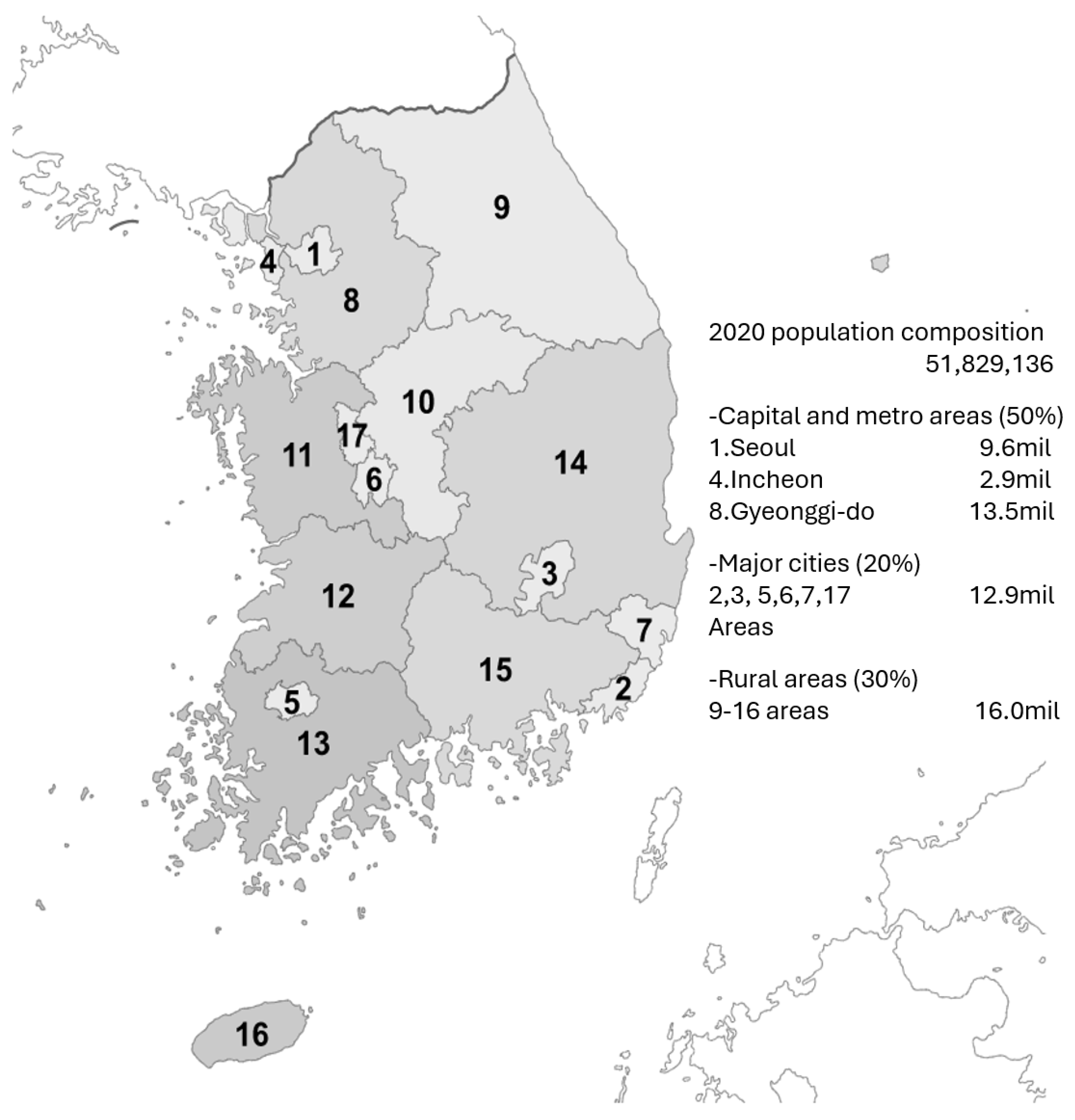
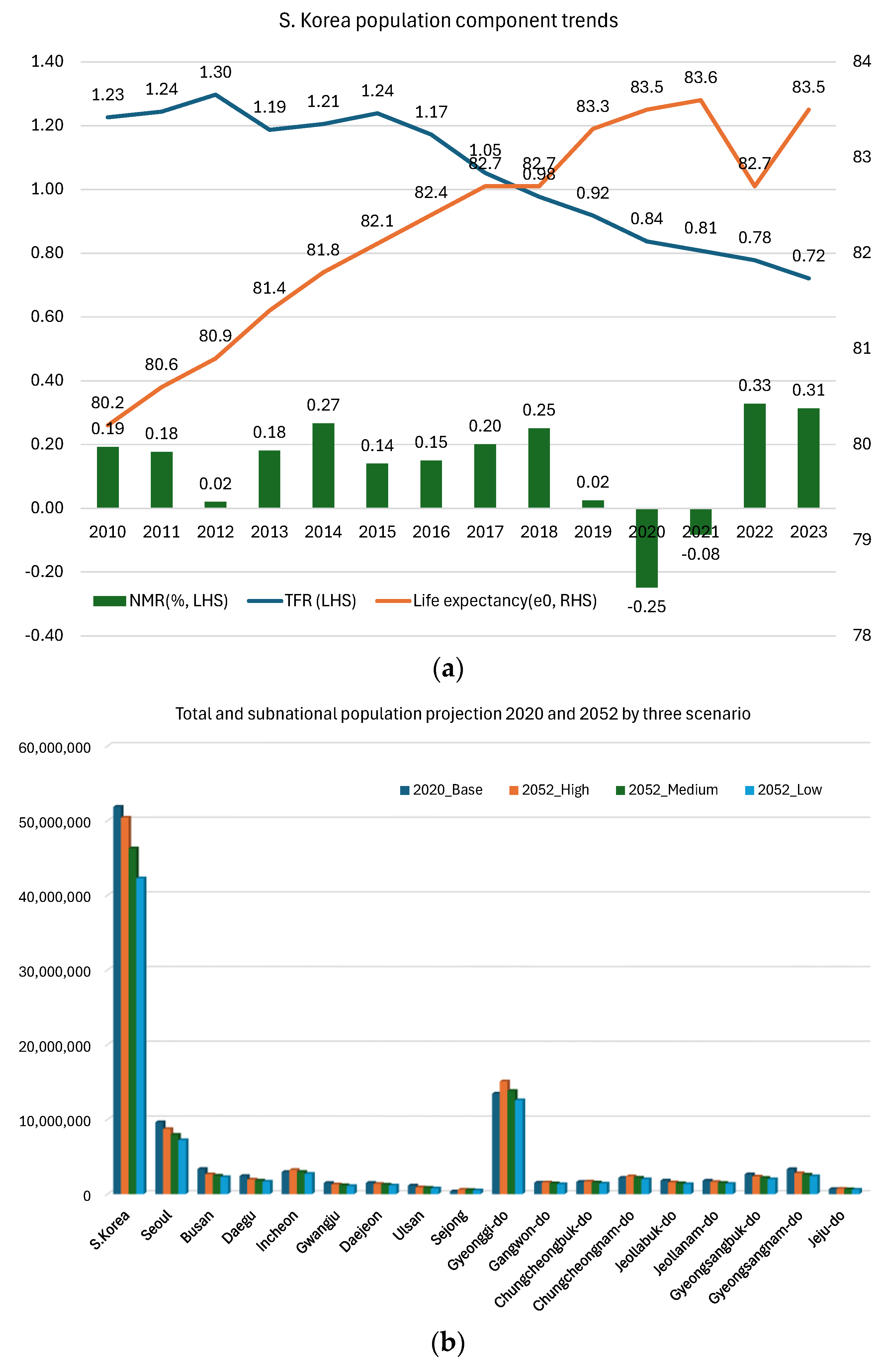
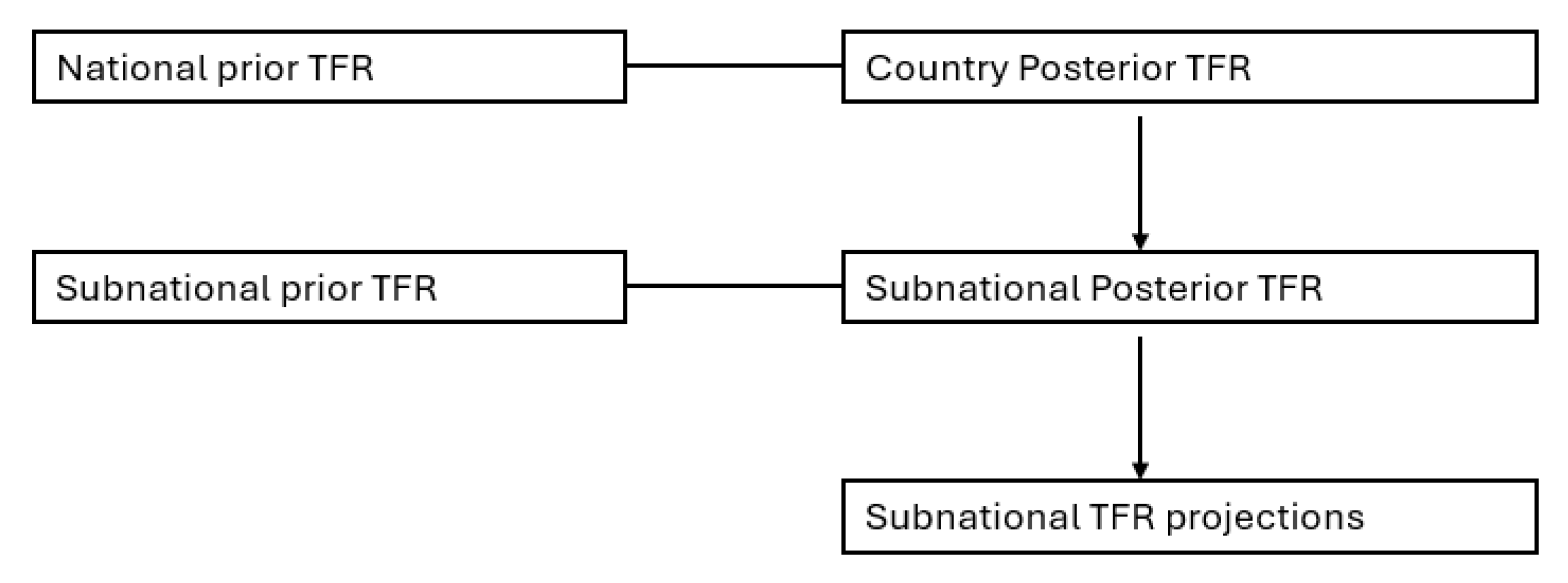
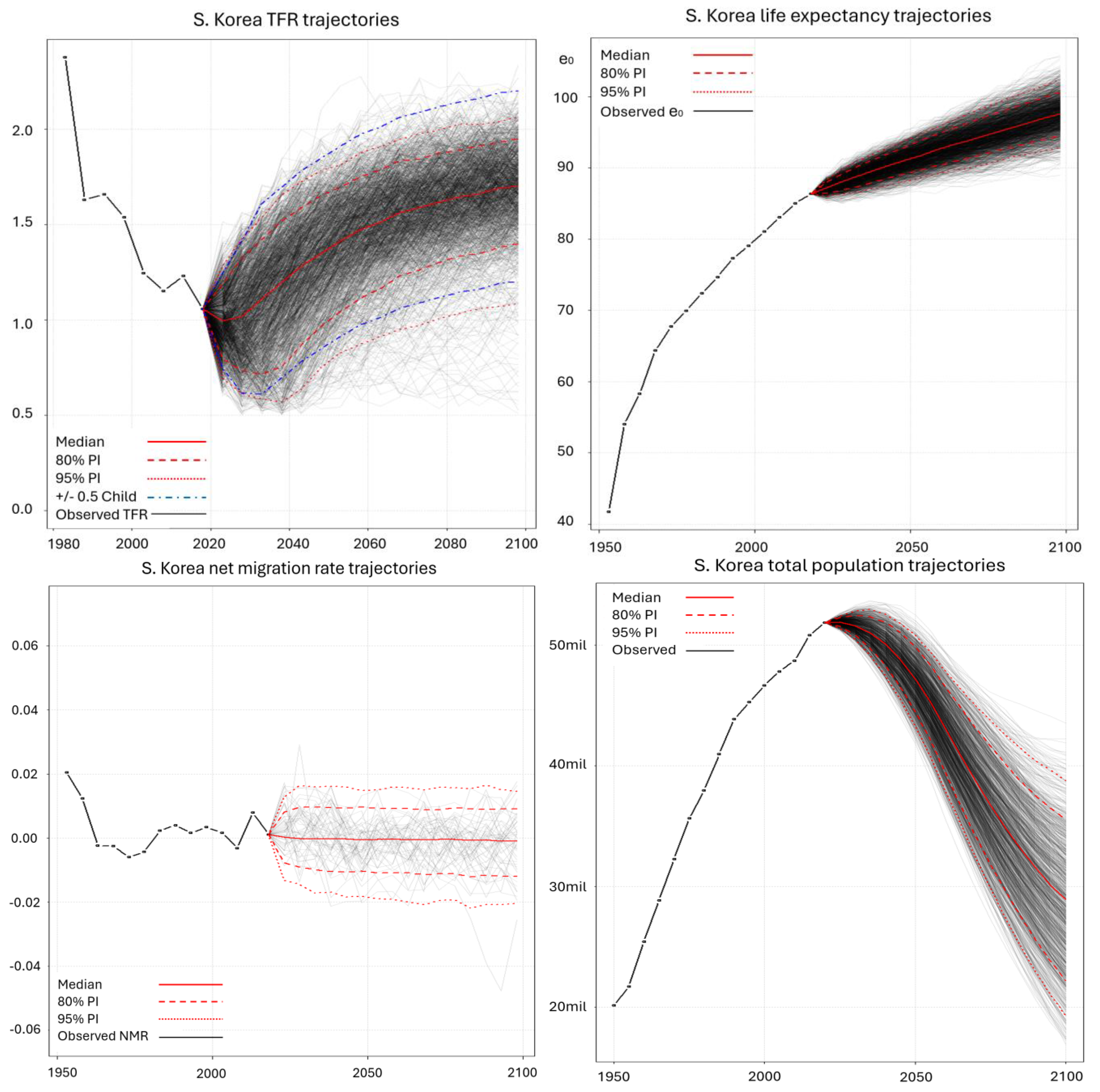

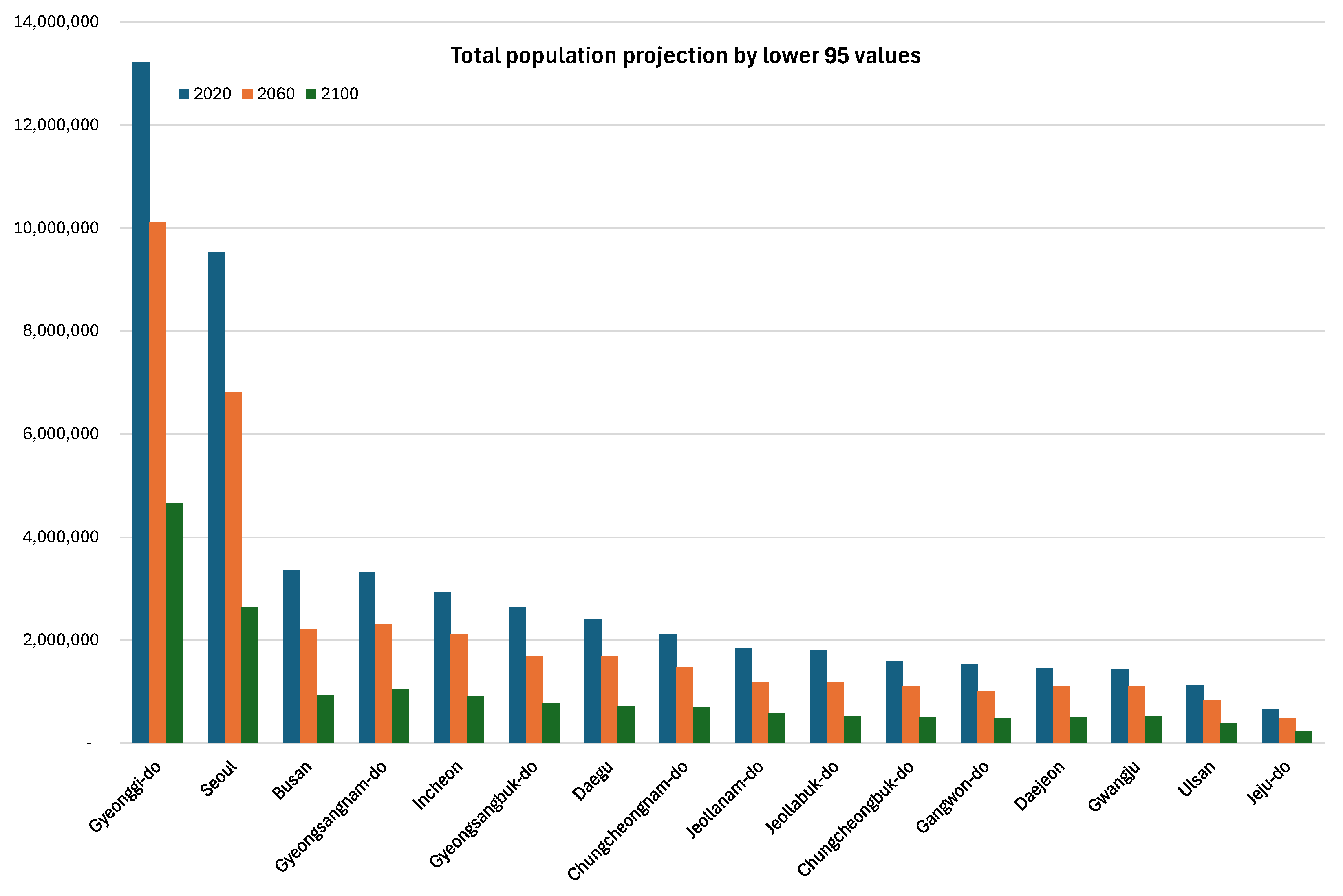
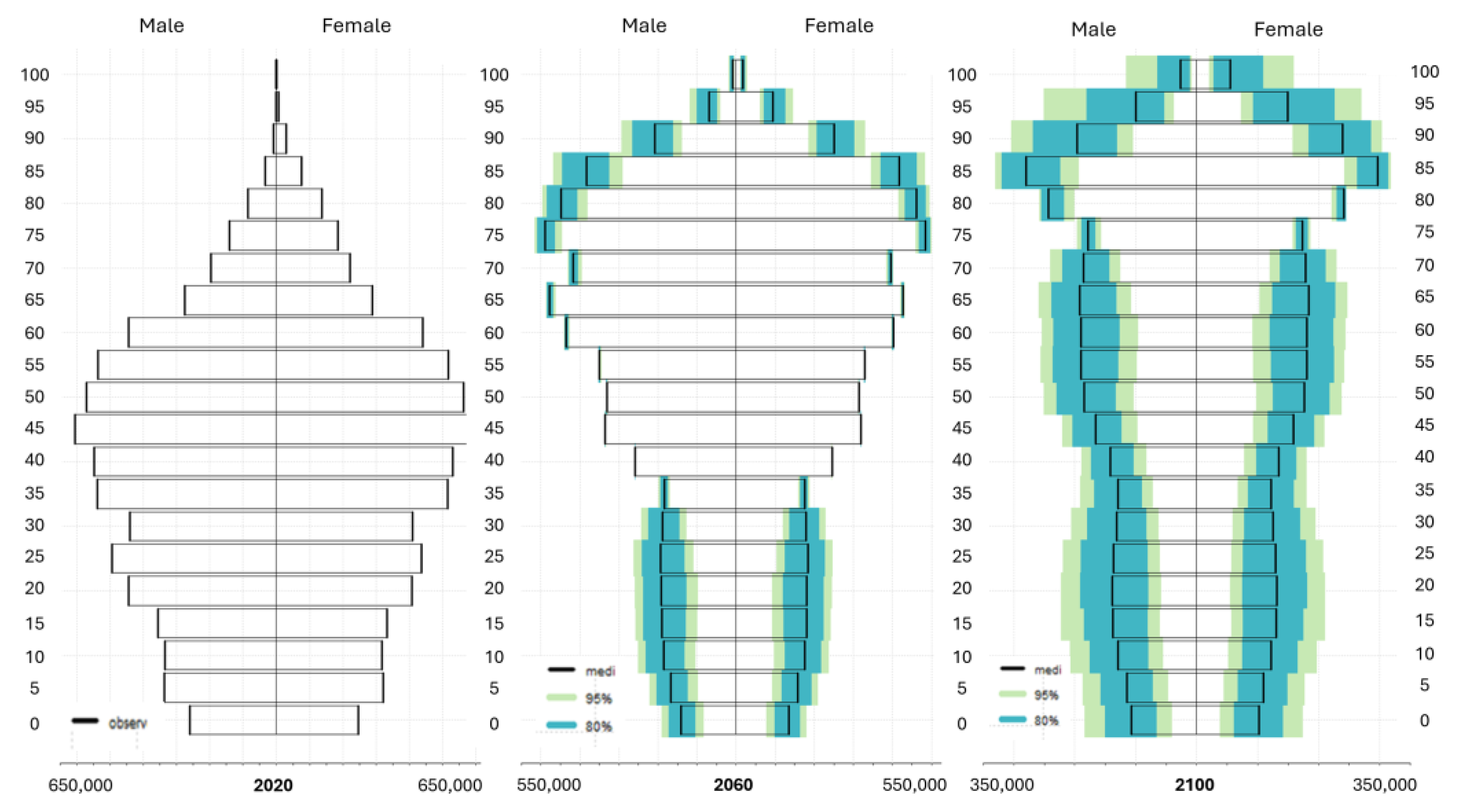
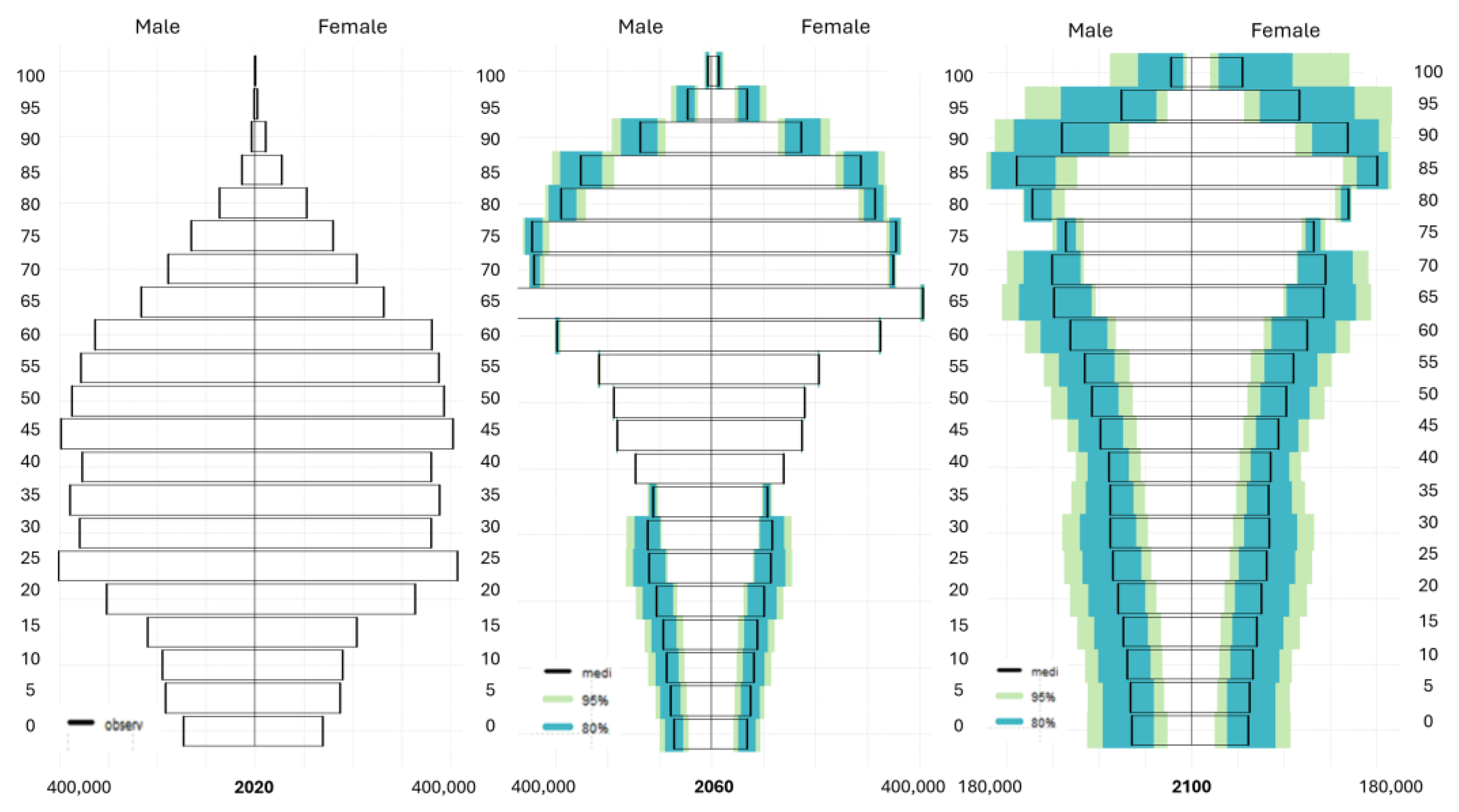


| 2030 | 2040 | 2050 | 2060 | 2070 | MAPE % | |
|---|---|---|---|---|---|---|
| KOSIS Projection | 51,306,000 | 50,059,000 | 47,107,000 | 42,302,000 | 37,182,000 | |
| Bayesian Projection | 51,592,000 | 50,085,000 | 47,161,000 | 43,153,000 | 38,806,000 | |
| APE % | 0.56 | 0.05 | 0.11 | 2.01 | 4.37 | 1.42 |
| lower 95 | 50,463,000 | 47,458,000 | 43,275,000 | 38,033,000 | 32,502,000 | |
| APE % | 1.64 | 5.20 | 8.13 | 10.09 | 12.59 | 7.53 |
| upper 95 | 52,796,000 | 52,536,000 | 50,803,000 | 47,906,000 | 45,028,000 | |
| APE % | 2.90 | 4.95 | 7.85 | 13.25 | 21.10 | 10.01 |
Disclaimer/Publisher’s Note: The statements, opinions and data contained in all publications are solely those of the individual author(s) and contributor(s) and not of MDPI and/or the editor(s). MDPI and/or the editor(s) disclaim responsibility for any injury to people or property resulting from any ideas, methods, instructions or products referred to in the content. |
© 2025 by the author. Licensee MDPI, Basel, Switzerland. This article is an open access article distributed under the terms and conditions of the Creative Commons Attribution (CC BY) license (https://creativecommons.org/licenses/by/4.0/).
Share and Cite
Kim, J. Probabilistic Projections of South Korea’s Population Decline and Subnational Dynamics. Forecasting 2025, 7, 40. https://doi.org/10.3390/forecast7030040
Kim J. Probabilistic Projections of South Korea’s Population Decline and Subnational Dynamics. Forecasting. 2025; 7(3):40. https://doi.org/10.3390/forecast7030040
Chicago/Turabian StyleKim, Jeongsoo. 2025. "Probabilistic Projections of South Korea’s Population Decline and Subnational Dynamics" Forecasting 7, no. 3: 40. https://doi.org/10.3390/forecast7030040
APA StyleKim, J. (2025). Probabilistic Projections of South Korea’s Population Decline and Subnational Dynamics. Forecasting, 7(3), 40. https://doi.org/10.3390/forecast7030040






